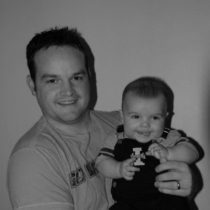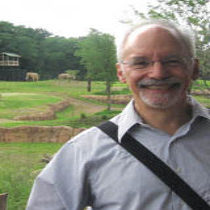Landscape Architecture for Landscape Architects › Forums › PLANTS & HORTICULTURE › Observations? Thoughts?
- This topic has 1 reply, 7 voices, and was last updated 7 years, 6 months ago by
 Robert Anderson.
Robert Anderson.
-
AuthorPosts
-
October 7, 2016 at 1:58 pm #151222
Greg Byrer
ParticipantCame across this during a site inspection…….would be interested in other professional observations/thoughts. FYI….I did not plant this.
October 7, 2016 at 3:01 pm #151231 Robert AndersonParticipant
Robert AndersonParticipantNot sure where you want us to start? It looks like they got the depth right and the green side is up! Is the tree still alive? That would be important to note as it surely will not last much longer. The rope and fabric around the ball will ultimately kill the tree if the lack of freedom for the roots to escape the fabric doesn’t kill it first.
Are you there for new work or as a third party reviewer of the previous installation? Either way you should recommend that they fix this, and mostly all the other errors given the gross negligence shown here.
October 7, 2016 at 3:25 pm #151230Greg Byrer
ParticipantRobert-Definitely green side up, so that’s good…..and the tree is still alive!
The main reason for the post is to see what people’s opinions are regarding the twine, burlap and wire, removal or not, and why. I personally prefer to remove the basket (if possible) and cut away the twine and burlap from around the base and top of the root ball. I have seen trees like this a few years later, and the burlap and twine is being engulfed by the bark growing around it.
As far as why I was there…..I am not able to dwell on it at any level.
Everyone has a different approach and I have seen all ways….just interested to see how others like to plant B&B material.
October 7, 2016 at 3:34 pm #151229 Robert AndersonParticipant
Robert AndersonParticipantGreg,
One should always remove the “burlap” not really burlap these days as it is more often than not synthetic and therefore not degradable as is the same for the twine. Always cut these away and remove to well below the root zone of the tree or shrub that you are planting. Remove the cage if you can but at the very minimum cut it to that same depth.
As you observed these items left around the trunk will eventually have the tree grow around but ultimately they will girdle the tree and kill it or make it very weak and susceptible to disease.
I’ve been trying of late to get bare root material as it has been proven to get established faster and the carbon footprint is way down as you don’t have to haul those heavy rootballs.
October 10, 2016 at 6:06 pm #151228 Scott LebsackParticipant
Scott LebsackParticipantIn my experience, the burlap is biodegradable – part of the point – but I mostly work with stock out of the pacific northwest. Everything should definitely be removed from the trunk and the top 1/3 of the rootball should be exposed – cut the twine and pull the burlap back.
I was recently involved in a discuss with a Landscape Contractor and another LA on site regarding B&B vs. pots and installation practices. the LC will not warranty any B&B plant that has the cage removed, because this will result in damage to the rootball and as a result the roots. If a client is insistent on plants without cages, they get plants in pots.
October 11, 2016 at 11:55 am #151227 Andrew Garulay, RLAParticipant
Andrew Garulay, RLAParticipantThe hole for the root ball should be large enough to get enough access to cut away the sides of the cage under most circumstances. Sometimes the burlap can be in degraded condition and the root ball weakened, so removing the basket and/or the burlap is not always “text book”, but the best effort to minimize further damage has to be balanced with the best effort to minimize future damage from the cage.
Not removing the string and burlap around the trunk itself is inexcusable.
The biggest concern that I have with the burlap is more about interrupting the contact and connectivity between the root ball soil and surrounding soil than its physical threat to the growing roots in the future. We should not underestimate the consequence of the burlap exposed to the atmosphere as it can wick moisture from the surrounding soil to the air rather than it passing through to the root ball soil.
Big pots can be very awkward to remove in a hole as well. The benefit with the pot is that you usually have more root structure in the root ball holding the soil together if the plant is grown in the pot. It is not a help if they just take trees with degraded root balls and pot them in order to handle and store them.
The best thing to do, in my opinion, is to assess the root balls whether in a pot or b&b and use your best judgment to determine how they should be handled. This is where being very familiar with your contractors is so important if you are managing the project.
October 14, 2016 at 10:24 am #151226 Rob HalpernParticipant
Rob HalpernParticipantAdding to what has already been posted: far too many b&b plants are coming out of nurseries with poor root systems or having been planted too beep in nursery We must be able to get a look at the root ball at planting in order to correct any issues. Where is the root flare? Don’t know: can’t see it.
There also is growing scientific consensus that the best future for a plant is a complete root washing so that the tree (shrubs, whatever) is planted basically bare root. Fastest adaptation to new soil environment. There is little good to be said about what this contractor did. But they have learned that the death of the tree will occur long after any warranty has expired
October 14, 2016 at 12:36 pm #151225 Rob HalpernParticipant
Rob HalpernParticipant… And then there’s the sad attempt at mulching
October 14, 2016 at 3:41 pm #151224 Tyson CarrollParticipant
Tyson CarrollParticipantTwine and burlap should be removed as Robert mentions. Regarding warranty of the plant as it relates to the LC, it all depends on what is written in the docs and specs. Some project require root shaving or corrections by the LC other simply reject plants that arrive onsite that do not meet spec.
As rob mentions too many plants coming out of the nurseries have poor roots systems both for b&b and container. Containers have more opportunities for root defects. Root defects can be dealt with through corrections but requires more time and a client who values plants. It is easier to get a better grown plant than to get a contractor on board with corrections. More LA’s need to inspect and or reject plants from the job site and nurseries need to do a better job with production. It is getting better but change is slow.
UTF in collaboration with Dr. Ed Gilman, Jim Urban, CDF and the ISA put out specs and details for planting. A part of that deals with plant observation and plant corrections. Free to download and use. http://www.urbantree.org.
October 18, 2016 at 8:46 pm #151223 Barbara PetersonParticipant
Barbara PetersonParticipantExcellent replies. Additional information in lines with Robert and Rob:
1. The tree is not necessarily planted at the correct depth. Without removing the burlap, the contractor could not have adequately checked the location of the root flare. Quite often, you’ll find several inches of soil between the root flare and the burlap. So by assuming that the flare is just ‘under’ the burlap and not verifying, the flare is installed below the adjacent finished grade…too low. I carry a surveyor spike on site visits. When I don’t see a tree’s root flare, I use the spike to poke around the base of the tree to locate the flare. I note every tree that has been planted to low or that still has the burlap or wire on it on the site report with a clarification on why the installation is not correct.
2. The burlap and wire do not degrade. I have seen numerous B&B trees that have been installed 10+ years ago where the trunk has grown around / over the burlap, twine, and/or wire cage.
I have attached two photos. In the first image (018.jpg), you can see the rusty wire cage. I would estimate the original work to have been done 15+ years years ago (based on building style). I pulled and tugged at the wire and even tried garden shires (no wire cutters in my trunk)…it did not break. In the second image (079.jpg), the straps are clearly visible. The tree has grown around the straps as opposed to “popping them”.
I am disappointed when I see trees left this way because tree health is compromised and the Owner is not getting what they paid for. I can only assume (hope) that this type of installation is a result of CA not being included in the project scope or that the Owner or Architect approved the installation. (I have sadly been on projects where my site visit comments were disregarded because the project completion date / opening was “more important”.)
-
AuthorPosts
- You must be logged in to reply to this topic.

